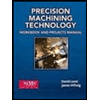Problem 21.4. An inspector’s accuracy has been assessed as follows: p1 = 0.96 and p2 = 0.60. The inspector is given the task of inspecting a batch of 500 parts and sorting out the defects from good units. If the actual defect rate in the batch is 0.05, determine (a) the expected number of Type I and (b) Type II errors the inspector will make. (c) Also, what is the expected fraction defect rate that the inspector will report at the end of the inspection task.
Problem 21.4. An inspector’s accuracy has been assessed as follows: p1 = 0.96 and p2 = 0.60. The inspector is given the task of inspecting a batch of 500 parts and sorting out the defects from good units. If the actual defect rate in the batch is 0.05, determine (a) the expected number of Type I and (b) Type II errors the inspector will make. (c) Also, what is the expected fraction defect rate that the inspector will report at the end of the inspection task.
Precision Machining Technology (MindTap Course List)
2nd Edition
ISBN:9781285444543
Author:Peter J. Hoffman, Eric S. Hopewell, Brian Janes
Publisher:Peter J. Hoffman, Eric S. Hopewell, Brian Janes
Chapter2: Measurement, Materials, And Safety
Section2.4: Precision Measurement
Problem 14RQ: What is calibration and why is it important?
Related questions
Question
- Problem 21.4. An inspector’s accuracy has been assessed as follows: p1 = 0.96 and p2 = 0.60. The inspector is given the task of inspecting a batch of 500 parts and sorting out the defects from good units. If the actual defect rate in the batch is 0.05, determine (a) the expected number of Type I and (b) Type II errors the inspector will make. (c) Also, what is the expected fraction defect rate that the inspector will report at the end of the inspection task.
Expert Solution
This question has been solved!
Explore an expertly crafted, step-by-step solution for a thorough understanding of key concepts.
This is a popular solution!
Trending now
This is a popular solution!
Step by step
Solved in 2 steps with 2 images

Knowledge Booster
Learn more about
Need a deep-dive on the concept behind this application? Look no further. Learn more about this topic, mechanical-engineering and related others by exploring similar questions and additional content below.Recommended textbooks for you

Precision Machining Technology (MindTap Course Li…
Mechanical Engineering
ISBN:
9781285444543
Author:
Peter J. Hoffman, Eric S. Hopewell, Brian Janes
Publisher:
Cengage Learning

Precision Machining Technology (MindTap Course Li…
Mechanical Engineering
ISBN:
9781285444543
Author:
Peter J. Hoffman, Eric S. Hopewell, Brian Janes
Publisher:
Cengage Learning